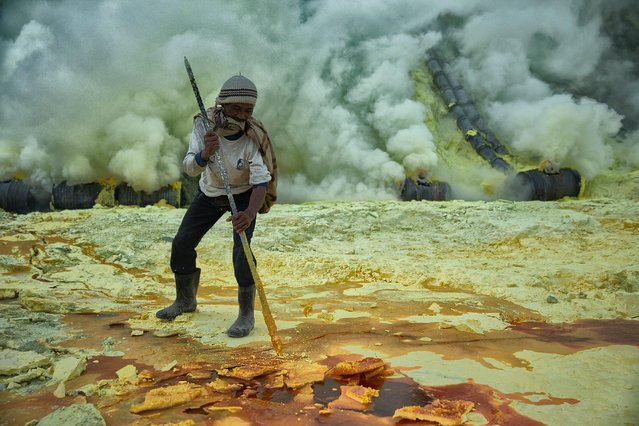
A miner chisels out chunks of sulphur as he readies his basket to carry out of the bowels of the Ijen volcano. Miners carried average 70 kilo loads one kilometre up and out of the volcano and then three kilometres down to a weigh station further down the mountain. Each miner undertook an average of two carries per day and received payment of around US$0.09 per kilogram carried. This miner can be seen chewing on his scarf to help prevent the ingress of sulphur dioxide and hydrogen sulphide into his body. Ijen volcano, Indonesia, 2012. A photographer has travelled the globe to capture people working in the world's most extreme conditions – with some risking their lives for a wage of less than $1 a day. Photographer Hugh Brown has spent more than eight years uncovering those who are exposed to the harshest and most dangerous ways of making a living. Up to 30 million people worldwide are forced to work in crippling conditions – from deep within underground mines, on the top of mountains and the side of sheer cliff-faces. The images have now been documented in a thought-provoking project named “The Cruellest Earth”, and will also be turned into a photographic art book. (Photo by Hugh Brown/South West News Service)
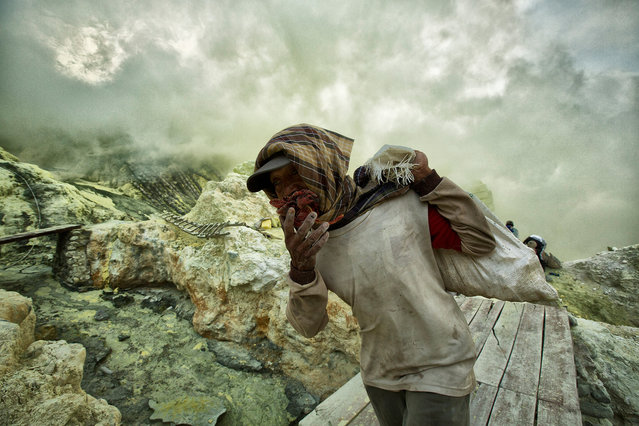
At the Ijen volcano ceramic pipes tap into an active volcanic vent. The sulphur rich gases come out of the vent from a magma chamber some 20 kilometres below the surface and cool when they hit the pipes causing them to condense into a liquid and then solidify. At the time of reaching the surface the gases can be as hot as 600 degrees celcius. Ijen volcano, Indonesia, 2012. (Photo by Hugh Brown/South West News Service)

A sulphur miner in Indonesia’s Ijen volcano gasps in pain in air thick with sulphur dioxide and hydrogen sulphide. When the sulphur from these gases mixes with the moisture in one’s eyes, lungs and throat it creates sulphuric acid. Hence the screaming in pain. Ijen volcano, Indonesia, 2012. (Photo by Hugh Brown/South West News Service)
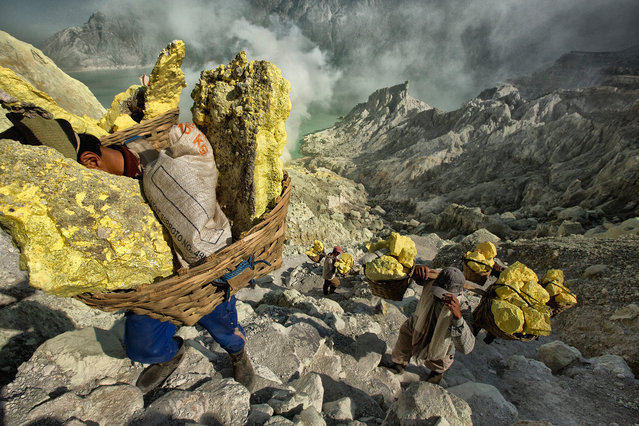
Sulphur miners haul sulphur up an arduous path out of Indonesia’s Ijen volcano. The average carry out of the volcano is 70 kilograms per load per miner. The all-time record carry was 120 kilograms in one load. Extraordinary numbers given most of the miners only weigh around 55 kilograms. Ijen volcano, Indonesia, 2012. (Photo by Hugh Brown/South West News Service)
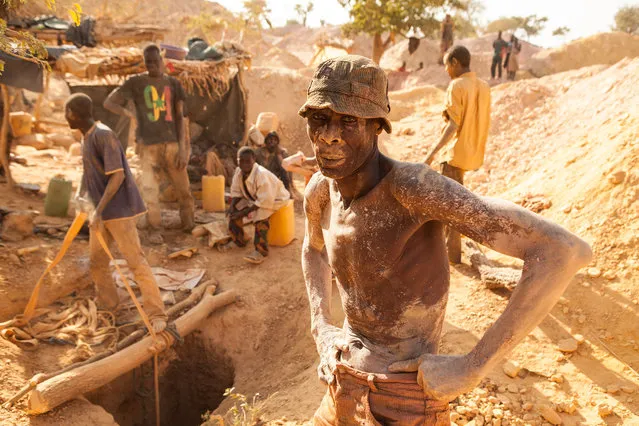
Miner in Burkina Faso 2010. Weathered by years of hard work he was in reality no different to the people of the world’s major cities. He had sacrificed working in the villages and fields for the prospect of a better life. For money in the mines can be infinitely better than in other vocations if one strikes it rich. But hours are long. Work is dangerous. And many people die. (Photo by Hugh Brown/South West News Service)

This artisanal gold site in Burkina Faso was home to some 10,000 people. And while these locations can be home to some of the more difficult aspects of humanity (extremism, organised crime, environmental degradation, slavery, etc.) they also provide unique upward mobility pathways for people to move from extreme poverty and into more skilled vocations such as those we are used to in the developed world. (Photo by Hugh Brown/South West News Service)
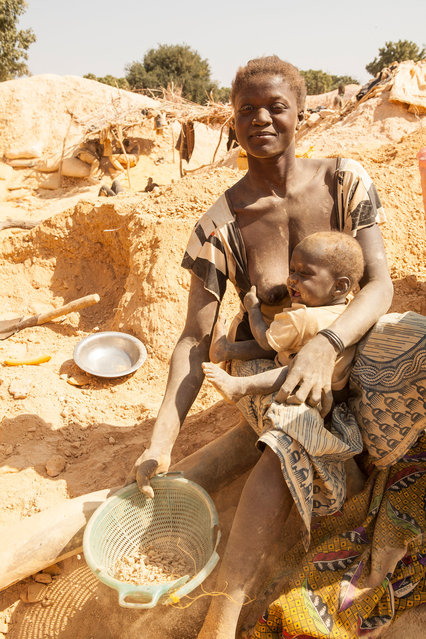
Burkina Faso, West Africa 2010. A woman and her newborn son process freshly recovered ore in the goldfields of West Africa’s Burkina Faso. Work in the mines is long and hard with little differentiation between the sexes other than that the men do the mining and many women help with the processing. (Photo by Hugh Brown/South West News Service)
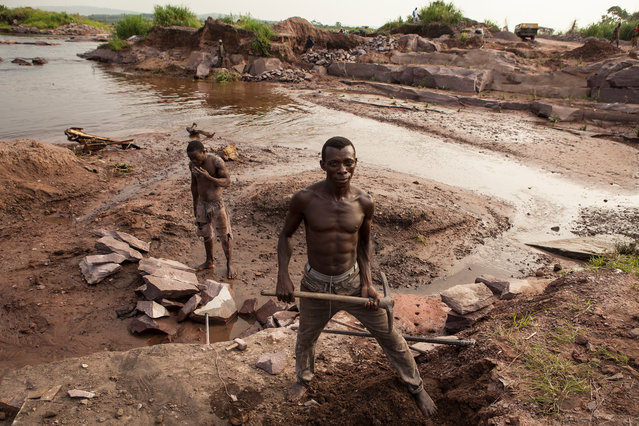
Stone miner on the banks of the Fleuve Congo in the Republic of Congo, 2010. (Photo by Hugh Brown/South West News Service)
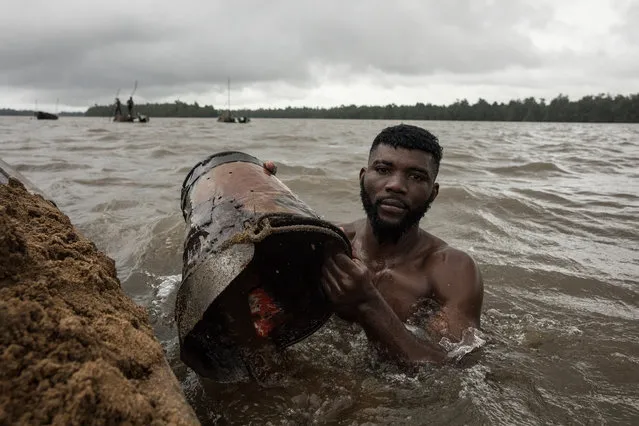
Cameroon, 2017. Sand diver, Simon. Simon was the strongest diver on this section of river. A former boxer he was a self-made man. Working his way up to buy his first pirogue, and then a second and then a third and finally a fourth. Simon harboured ambitions to move abroad and to start a new life. On average each diver retrieved around 1.7 tonnes of brickies sand in a roughly three hour shift. Incredible given that each bucket held around 15 kilos of sand. (Photo by Hugh Brown/South West News Service)
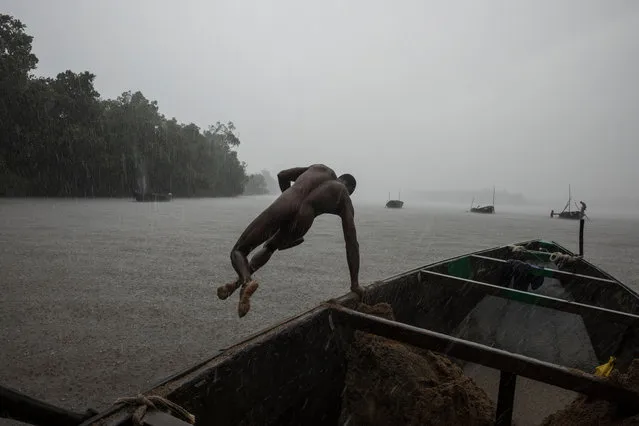
Sand diver, Cameroon, 2017. These men dived for brickies sand in the fast moving Douala Estuary in eastern Cameroon. The work was brutal and dangerous and the miners dived around the low tide. Deaths occurred periodically and some of the hazards included sand being ingested into ears and major orifices, the benz, being knocked out on the hull of the boat when surfacing too quickly in the wrong place and then drowning on being washed away by the tide, venomous snakes coming down on floating weed mates, stingrays, etc. (Photo by Hugh Brown/South West News Service)
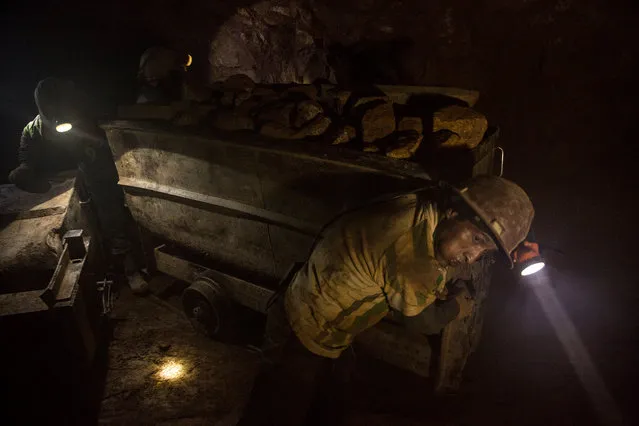
Miners move an ore wagon of silver deep inside Bolivia’s Cerro Rico silver mines. The work here is incredibly dangerous. And even today deaths are common. (Photo by Hugh Brown/South West News Service)
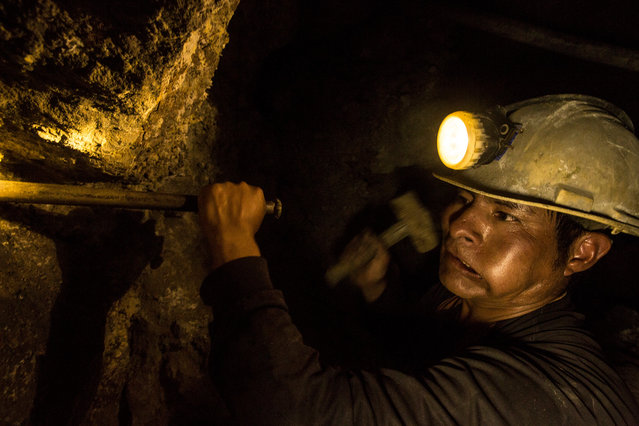
Cerro Rico, Bolivia, 2016. A percussion underground silver miner manually chisels out blast holes for the placement of dynamite deep in Cerro Rico’s underground silver mines. In an eight hour shift this miner will be lucky to chisel out between two and four 30 centimetre blast holes. (Photo by Hugh Brown/South West News Service)
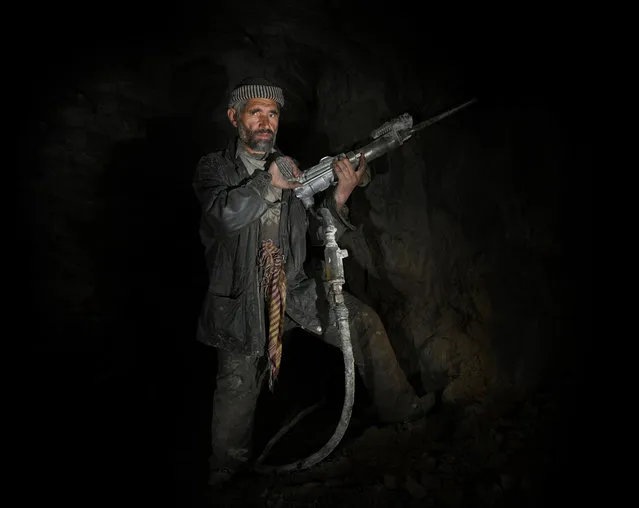
An underground gem miner works an airleg drill high in Northern Pakistan’s Karakorum Range. While mines were technically supposed to be around three feet apart, these separations had reduced in recent years creating a significant rock fall and blasting hazard for those working close to the faces of their mines. (Photo by Hugh Brown/South West News Service)
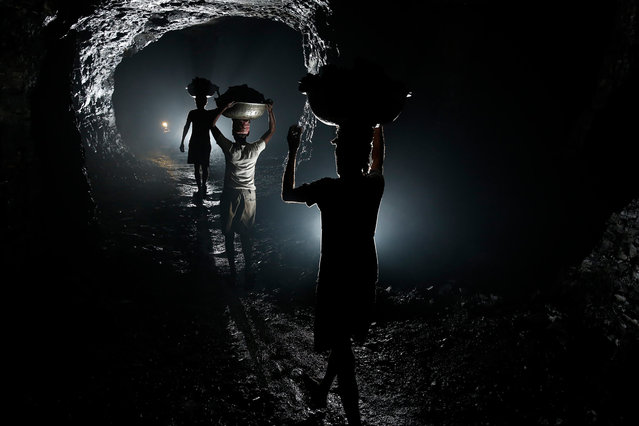
Bojharis carry coal chiselled out by coal cutters in an illegal underground coal mine in Eastern India. Average loads carried by these bojharis was around about 40 kilograms at a time. In this mine the miners had sought the input of a mining enginner to choose the placement of pillars within the mine and so minimise the risk of collapses. Eastern India, 2013. (Photo by Hugh Brown/South West News Service)
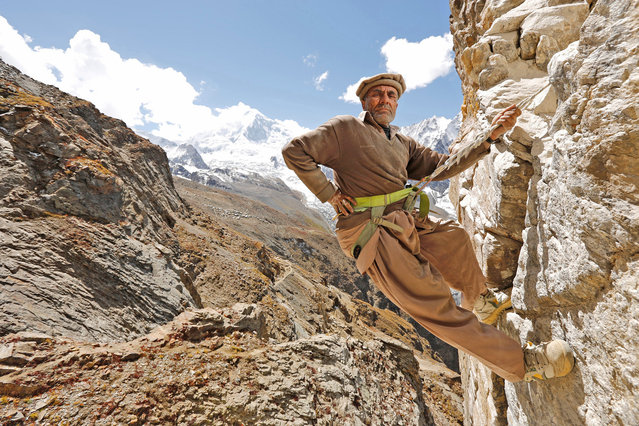
High in Northern Pakistan’s Karakorum Range an illegal gem miner climbs up to his mine. These miners are amongst the highest in the world with this mine being located just short of 5,000 metres. (Photo by Hugh Brown/South West News Service)
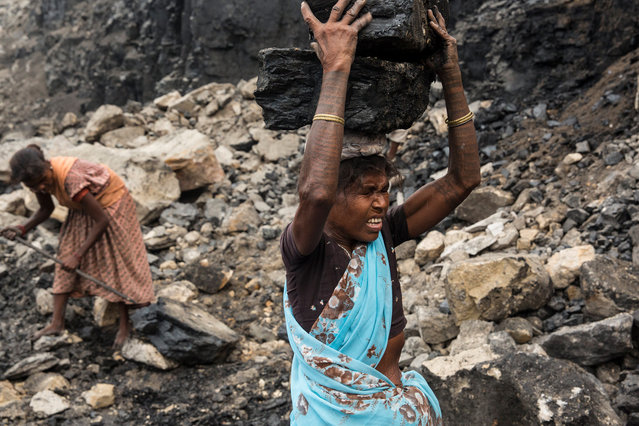
A woman – an illegal coal scavenger – hauls a heavy block of coal out of an operating open-cut coal mine in eastern India. She is a member of India’s adivasis indigenous people. Jharkhand, India, 2013. (Photo by Hugh Brown/South West News Service)
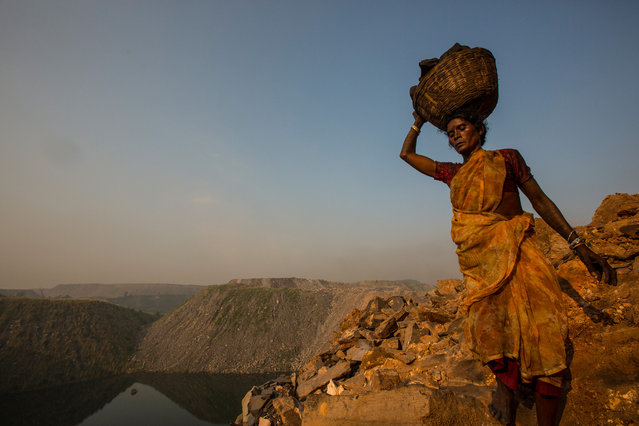
An illegal coal scavenger retrieves a large block of coal from a working open-cut coal mine in eastern India. The climb out of the mine is treacherous with a precipitous drop down one side likely to lead to death. Jharkhand, India, 2013. (Photo by Hugh Brown/South West News Service)
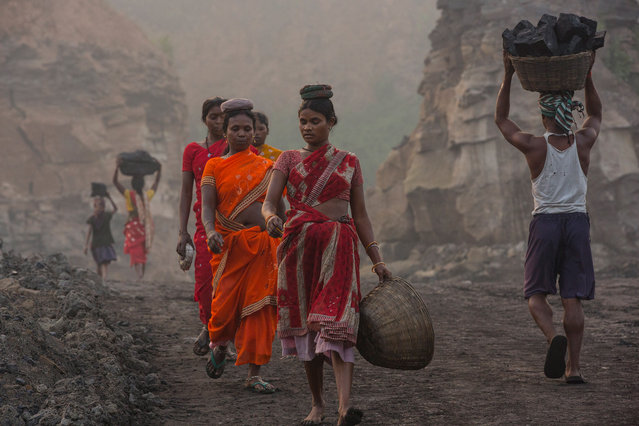
Illegal coal scavengers descend into a working open-cut coal mine in eastern India. For an hour each morning in between shift change when the large-scale earthmoving equipment stops working these illegal coal scavengers work rapidly to retrieve as many large blocks as they can. Jharkhand, India, 2013. (Photo by Hugh Brown/South West News Service)
30 Jul 2018 00:05:00,
post received
0 comments
